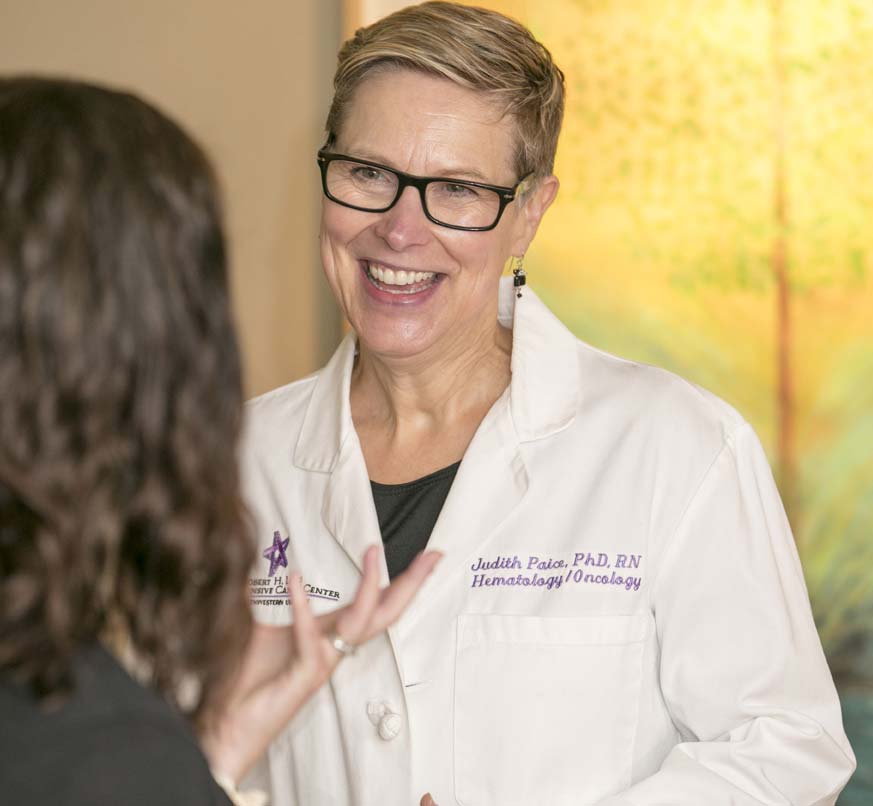
The Opioid Epidemic and Cancer Pain Management: A Conversation with Dr. Judith Paice
July 16, 2018, by NCI Staff
Pain is a common symptom in cancer patients. It can be caused by cancer, its treatments, or a combination of factors. Although some pain lasts a relatively short time and will resolve on its own, cancer or its treatments can also lead to long-lasting, chronic pain. Opioid medications are an important component of managing some types of unrelieved cancer pain.
In this interview, Judith Paice, Ph.D., R.N., director of the Cancer Pain Program at Northwestern University’s Feinberg School of Medicine, discusses the impacts of the opioid epidemic and how providers can address concerns about opioid misuse when managing cancer pain.
First of all, what types of medications or other approaches are used to manage pain in cancer patients and survivors?
Any of the prescription opioid medications can be used for people with cancer. Non-opioid agents, including medications like acetaminophen (Tylenol) and ibuprofen (Motrin or Advil), are also used. For nerve pain, we may use antiseizure medications like gabapentin (Neurontin or Gralise) or antidepressant-type medications like duloxetine (Cymbalta).
Oncology care providers rely heavily on opioids, but we never rely only on opioids. We’re always using multiple therapies that work in different ways. That includes other pharmacologic (drug) therapy, and, as much as possible, non-pharmacologic approaches such as physical therapy, occupational therapy, orthotics, cognitive behavioral therapy, and massage and other integrative therapies.
How has the opioid epidemic affected cancer patients, cancer survivors, and their family members?
It has enhanced fear—fear of addiction in particular—such that some patients are very reluctant to take opioid medications for pain. Sometimes, it’s not the patient but the family member who is concerned [about addiction]. As a result, family members may withhold medicine from a loved one who is in pain, or they may question that person’s need for opioid medications, even when that person is at the end of life.
Another major effect is reduced access to opioid pain medications. Recently released results of a study by the American Cancer Society Cancer Action Network and the Patient Quality of Life Coalition show that one-third or more of cancer patients and survivors are having difficulty getting access to their prescribed opioid medications and that the proportion of people experiencing such difficulties has increased markedly since 2016. From a policy perspective, one of the major challenges we’re facing right now is the need to ensure that patients with cancer get the medications they need, and without significant delays.
How has concern about opioid misuse affected health care providers?
Many primary care doctors no longer prescribe opioids. Oncologists are still prescribing these medications, but in many cases they’re somewhat anxious about doing so. That has led some patients to have trouble even obtaining a prescription for pain medication.
There’s a great fear of legal action against people who prescribe opioids, and an awareness that prescribing practices are being monitored much more closely than in the past. In addition, insurance companies have made it much harder to obtain these medications, and as a result, more and more prescribers have been reluctant to introduce opioids into their patients’ care regimens.
Have there been any positive developments for cancer pain management as a result of the increased focus on the opioid epidemic?
To some extent, providers in the oncology community have looked more closely at our opioid prescribing practices … and are beginning to question the risk–benefit ratio of opioids more than we did in the past. As a community, oncology providers are beginning to look at long-term side effects of these medications, and whether their use is appropriate for the person who is not receiving active treatment, does not have active disease, and is going to live another 5, 10, or 20 years.
Are patient fears of opioid addiction a valid concern?
Anybody can have a disease of addiction. The prevalence of these diseases is unknown—it depends on how addiction is defined—but is likely around 10% or more in the general population. Furthermore, some of the risk factors for cancer are also risk factors for addiction, such as cigarette smoking and alcohol overuse.
Many people have assumed that people with cancer are not at risk for addiction, when in fact they may have the same risk as, or possibly even a greater risk than, the general population. Some people say, “Who cares if a cancer patient [with advanced disease] becomes an addict?” But many cancer patients do care, especially if they’ve had a problem with substance misuse in the past and have overcome that. These people may prefer to die with their sobriety intact.
What are the recommended best practices for using opioid medications to treat cancer?
Oncology care providers need to determine if opioids are the right drug for a particular type of cancer-related pain. According to a recent clinical practice guideline for chronic pain management in cancer survivors, published by the American Society of Clinical Oncology, careful assessment of the pain and its effect on function, and of the possible risks associated with use of an opioid, are the first step. When opioids are considered, providers should assess every patient for risk factors for addiction. Providers should also employ strategies to reduce the risk of misuse for all patients who are taking opioids. These strategies may include urine testing, checking state prescription drug monitoring programs to evaluate a person’s history of filling prescriptions for controlled substances, doing pill counts, and using patient–provider agreements or contracts. Each provider must determine what makes the best sense in their practice.
We need to employ these techniques for all patients because implicit bias can occur if we just take precautions for those patients we think are at risk for addiction. Addiction crosses all gender lines, all racial lines, all economic lines, and affects people of all ages.
With patients who are thought to be at high risk of developing a substance use disorder, providers may even decide not to use an opioid. Or we may need to prescribe smaller amounts of medication at a time.
How can providers achieve a balance between the need for adequate pain control and concerns about possible misuse of opioids?
The use of these very clear assessments and universal precautions allows prescribers to identify the potential for problems early on. Another important factor is that, unlike 10 or 20 years ago, the goal no longer is to eliminate pain completely, which is unrealistic. Instead, the goal is to reduce pain enough that patients can fully function to the best of their capabilities.
We providers have to educate our patients to help them understand that the role of opioids and other pain medications is to allow them to move and function better.
For some people, that may mean being able to walk around the block. For some, controlling the pain will allow them to return to work. And for those patients who are more fragile, the goal of pain medications may be to make them sufficiently comfortable to be able to hold their grandkids, or to sit comfortably on a hard chair in a church or restaurant.
























.png)











No hay comentarios:
Publicar un comentario